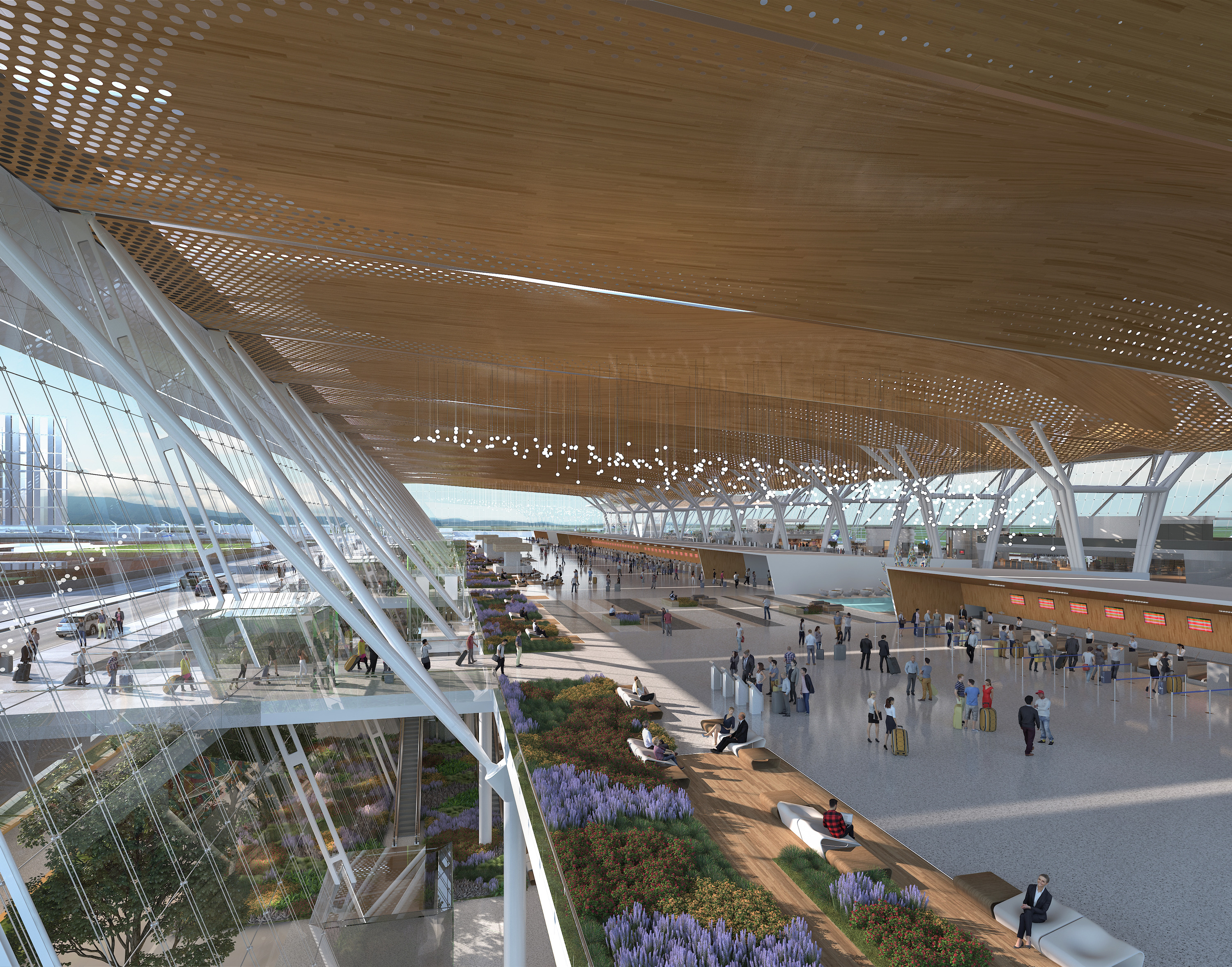During the first 10 days of August, the number of passengers who boarded airplanes in the U.S. averaged fewer than 35% of the number who flew during the those same days a year earlier, according to Transportation Security Administration daily checkpoint counts.
The aviation industry that’s been grounded by the coronavirus pandemic isn’t expected to rebound fully for three to four years. Past shocks, like 9/11, may have prepared the aviation sector to endure trying times. But the virus’s psychological toll has been unique for this country, say AEC sources.
“The consensus among most experts is that it will take quite a long time for passenger confidence to return,” says Jenny Buckley, Americas Aviation Leader for Arup. For at least the remainder of this year, “everyone will be in survival mode.”
James Hall, Vice President-Aviation for Austin Commercial, adds that while leisure travel is inching its way back, uncertainty created by international travel bans and state quarantine requirements “will continue to dog the industry into 2021 and beyond.” Consequently, “the goal of minimizing operational costs and overall employment is at the forefront of every conversation.”
The impact of the coronavirus on airport construction and renovation has been mixed. Paul Dorsey, Vice President-Aviation for Manhattan Construction, cautions that the industry must come to grips with the distinct likelihood that some businesses will permanently limit corporate travel in favor of virtual meetings.
However, Dorsey, like other AEC sources, reports that while projects have been delayed or stopped altogether, others that were funded and already started have been moving forward. Michael Burnett, DBIA, Senior Vice President with Holder Construction, notes that with so much aging infrastructure in need of improvement, “we continue to see aviation opportunities over the next 12-15 months, but more renovations and less expansions.”
Bryant Farland, Regional Executive Officer for Skanska USA Building, cites a recent industry report from the Airport Consultants Council that estimates $138 billion in capital investments will be required through 2024, half of which for terminal projects.
One project that was deemed “essential” is the modernization of LaGuardia Airport in New York, where a joint venture between Skanska and Walsh Construction recently celebrated the opening of seven new gates within 250,000 sf of the airport’s Terminal B Western Concourse. When Terminal B is completed, the joint venture will have delivered 35 new gates.

BNA Vision is Nashville International Airport’s expansion program for which Corgan is serving as the Master Architect. Its biophilic design allows for the introduction of natural light that is sometimes dappled from clearstories and skylights while providing warmth through wood ceiling accents and greenery. This project includes the removal and replacement of the roof across the heart of the building. Rendering: Corgan
Brent Kelley, Managing Principal and Aviation Section Leader for Corgan, says that some airport clients are “bullish” about completing work to take advantage of low passenger traffic and greater worker productivity and cost savings. Corgan is the master architect on Nashville International Airport’s “BNA Vision” growth and expansion program, which has included the removal and replacement of the airport’s roof, as well as multiple departmental relocations.
The same idea about getting work done now, while the airports aren’t crowded and entire concourses can be closed, drove the terminal lobby expansion at Charlotte Douglas International Airport in North Carolina, whose Building Team includes Holder and Gresham Smith. This expansion, explains Wilson Rayfield, AIA, LEED AP, Executive Vice President-Aviation for Gresham Smith, will “de-density” the terminal with more space for larger checkpoints and queuing areas.
Hall of Austin Commercial adds that more airports are implementing federal Disadvantaged Business Enterprise (DBE) programs, as federal funding for aviation has increased.
The scramble for fewer projects, though, has created a hotly competitive environment. Prior to the pandemic, Austin Commercial would expect to vie for contracts with four or five firms. But in recent months, the number of firms pursuing RFQs on projects in the $100 million to $200 million range has, in some cases, doubled, says Hall.
A touchless comfort zone in airport terminals
Corgan’s Kelley is among the AEC experts who believe that a turnaround in aviation’s fortunes is contingent on demonstrating to the public how airports and planes are being made safer. From an interior design perspective, Kelley says his firm is seeing a shift away from aesthetics and toward “a science-driven mentality” that places air quality, furniture design, and automation at the top of clients’ criteria.
To achieve their safety objectives, airports are “undergoing a technological transformation,” says Brian Reed, Aviation Development Director for Burns & McDonnell. He elaborates that the “world of biometrics” in particular “is addressing identity matching to eliminate touch points.”

Gresham Smith’s design for the terminal lobby expansion at Charlotte Douglas International Airport in North Carolina will create additional space and de-density the building’s capacity for travelers. Bigger checkpoints and queuing areas will reduce passenger clusters and limit to for possible exposure. Rendering: Gresham Smith
Reed isn’t the only AEC source who sees biometrics in more airports’ futures. Dorsey of Manhattan Construction can envision government-mandated temperature screening systems and isolation rooms implemented at airports’ entry points. (He fears, however, that without a national agenda, airport compliance would be “disparate.”)
Rayfield sees biometrics playing “a big role” in reducing touchpoints and creating a faster and arguably safer journey through the airport. Hall is convinced that passenger safety will be accomplished through improvements in self-checked bags, self-screening security, and touchless restrooms.
AEC sources agree that bringing passengers back to airports begins with creating a touchless environment in which healthcare-level cleanliness is emphasized. PCL Construction, for example, has developed its PURE Portal for baggage and cart sanitization and PURE Aviation to clean airplane interiors. Bob Hopfenberg, PCL’s Vice President-National Business Development in Denver, says the latter tool uses Sterilray technology and resembles a beverage cart with arms that emit FAR UV lights across an entire cabin.
“Everything is on the table, from curb to gate,” says Reed of Burns & McDonnell, “including baggage processing, security checkpoints, ticketing halls, passenger hold rooms, lounges and concessions. The pandemic has amplified the conversation for what future designs should look like.”
An inkling of that future might soon be found at Guadalajara Airport in Mexico, where CallisonRTKL’s design for a 30-gate, 1.2 million-sf Terminal 2 will reduce the airport’s energy use by 60% and its carbon footprint by 90%. The facility’s biophilic design includes landscaping that continues from the exterior to the interior of the space.
“The major trend is infusing health and wellness into terminal design and its DNA so that it is natural and seamless,” says Kap Malik, FAIA, IDSA, who leads CallisonRTKL’s aviation practice in Los Angeles. “ ‘Passenger wellbeing’ has become a key driver of overall passenger experience.” He adds that one of the biggest changes is touchless processing “from curb to gate.”
More diverse jobsites
As they attempt to recapture business by improving their physical plants, airports continue to evaluate alternative delivery methods like Design-Build and Construction Management at Risk (CMAR), says Hall of Austin Commercial. Skanska’s Farland observes that climate change mitigation is also getting attention, as is investment in air cargo facilities to accommodate ecommerce that has soared during the pandemic.
ALSO SEE: Curtis Fentress, FAIA, RIBA, on the STATE OF AIRPORT TERMINAL DESIGN AMID COVID-19

In this segment for BD+C's The Weekly, Curtis Fentress, FAIA, RIBA, Principal in Charge of Design with Fentress Architects, talks about the current and future state of air travel and airport terminal design amid COVID-19. Will we see a bounce back in airport construction? How will terminals be designed and operated differently post-COVID-19? What are some of the top design innovations to combat pandemic concerns and enhance infection control? Fentress and BD+C's David Barista discuss these topics and more. Watch on demand
In July, the Building Team that includes Hensel Phelps and Fentress Architects completed the $292 million, 302,400-sf Concourse D and Terminal Wings expansion at Nashville International Airport. This was that airport’s first progressive Design-Build project in its BNA Vision program, and it went from start of design to delivery in just 900 days, according to Scott Shelby, Hensel Phelps’ Operations Manager.
On this project, Hensel Phelps worked with 70 Small, Women, and Minority Owned Business partners with contracts totaling $55 million. As racial and gender economic and social equality have redefined the nation’s discourse, the composition of companies involved in construction projects is evolving toward greater diversity. Skanska-Walsh’s inclusion of MWBE businesses on the $8 billion LaGuardia Airport redevelopment is the largest partnering with MWBE firms to date on a single contract in New York State history.
Related Stories
| Jan 11, 2014
Getting to net-zero energy with brick masonry construction [AIA course]
When targeting net-zero energy performance, AEC professionals are advised to tackle energy demand first. This AIA course covers brick masonry's role in reducing energy consumption in buildings.
| Dec 13, 2013
Safe and sound: 10 solutions for fire and life safety
From a dual fire-CO detector to an aspiration-sensing fire alarm, BD+C editors present a roundup of new fire and life safety products and technologies.
| Dec 10, 2013
16 great solutions for architects, engineers, and contractors
From a crowd-funded smart shovel to a why-didn’t-someone-do-this-sooner scheme for managing traffic in public restrooms, these ideas are noteworthy for creative problem-solving. Here are some of the most intriguing innovations the BD+C community has brought to our attention this year.
| Nov 27, 2013
Wonder walls: 13 choices for the building envelope
BD+C editors present a roundup of the latest technologies and applications in exterior wall systems, from a tapered metal wall installation in Oklahoma to a textured precast concrete solution in North Carolina.
| Nov 26, 2013
Construction costs rise for 22nd straight month in November
Construction costs in North America rose for the 22nd consecutive month in November as labor costs continued to increase, amid growing industry concern over the tight availability of skilled workers.
| Nov 25, 2013
Building Teams need to help owners avoid 'operational stray'
"Operational stray" occurs when a building’s MEP systems don’t work the way they should. Even the most well-designed and constructed building can stray from perfection—and that can cost the owner a ton in unnecessary utility costs. But help is on the way.
| Nov 19, 2013
Top 10 green building products for 2014
Assa Abloy's power-over-ethernet access-control locks and Schüco's retrofit façade system are among the products to make BuildingGreen Inc.'s annual Top-10 Green Building Products list.
| Nov 15, 2013
Metal makes its mark on interior spaces
Beyond its long-standing role as a preferred material for a building’s structure and roof, metal is making its mark on interior spaces as well.
| Nov 13, 2013
Installed capacity of geothermal heat pumps to grow by 150% by 2020, says study
The worldwide installed capacity of GHP systems will reach 127.4 gigawatts-thermal over the next seven years, growth of nearly 150%, according to a recent report from Navigant Research.
| Oct 30, 2013
11 hot BIM/VDC topics for 2013
If you like to geek out on building information modeling and virtual design and construction, you should enjoy this overview of the top BIM/VDC topics.

















